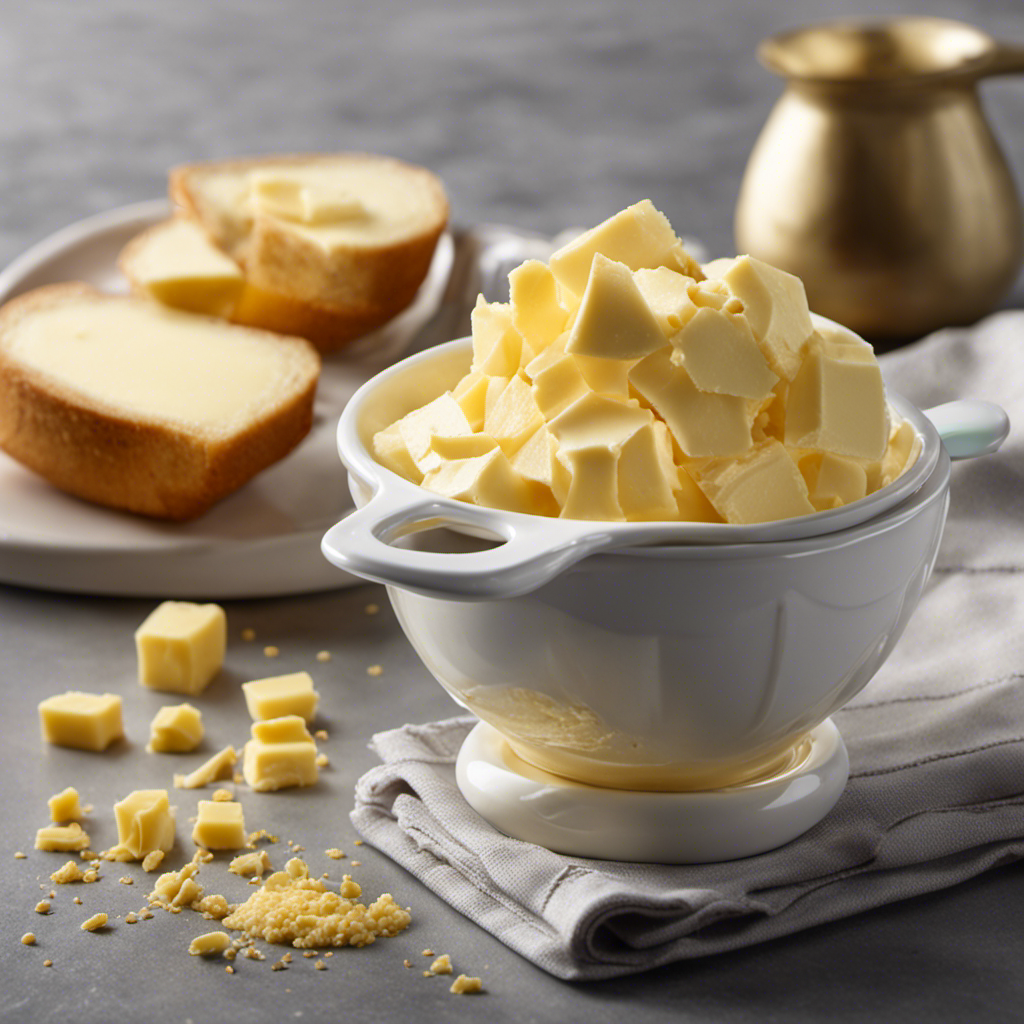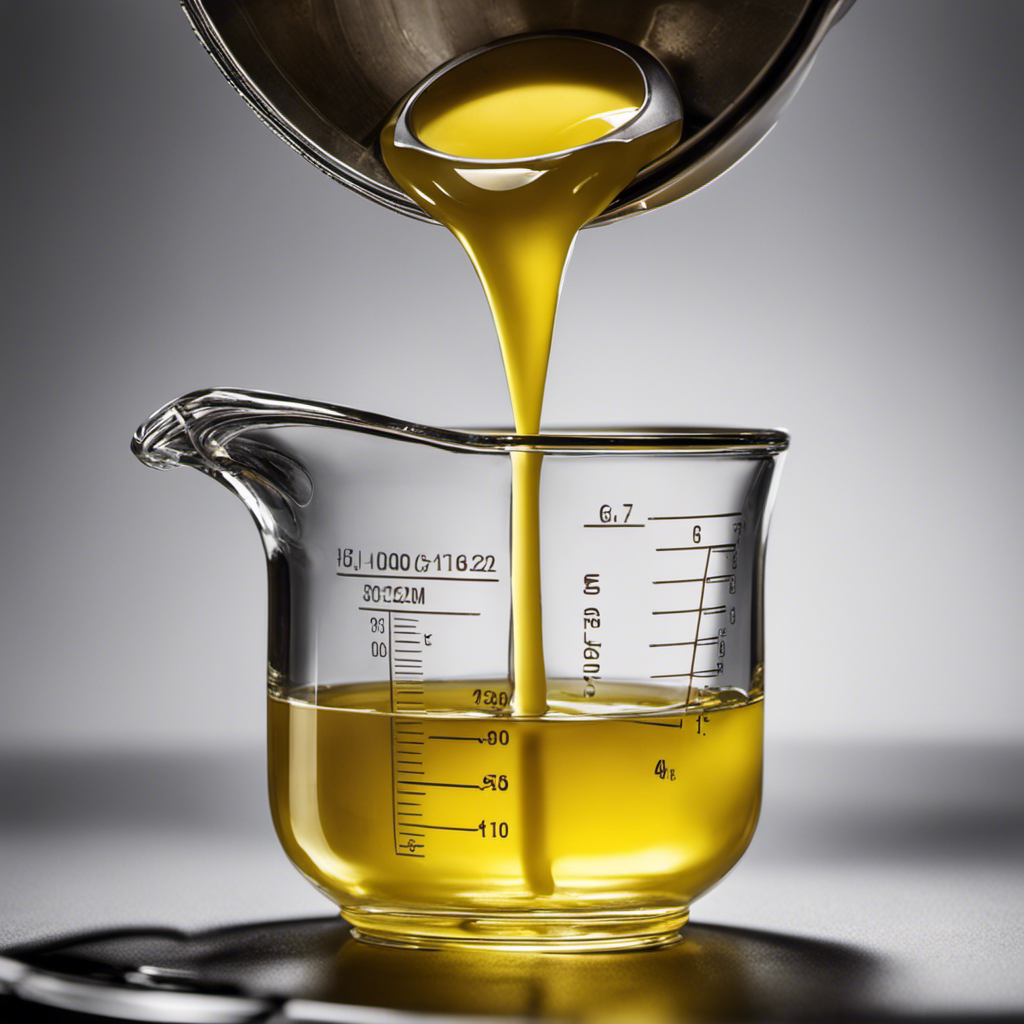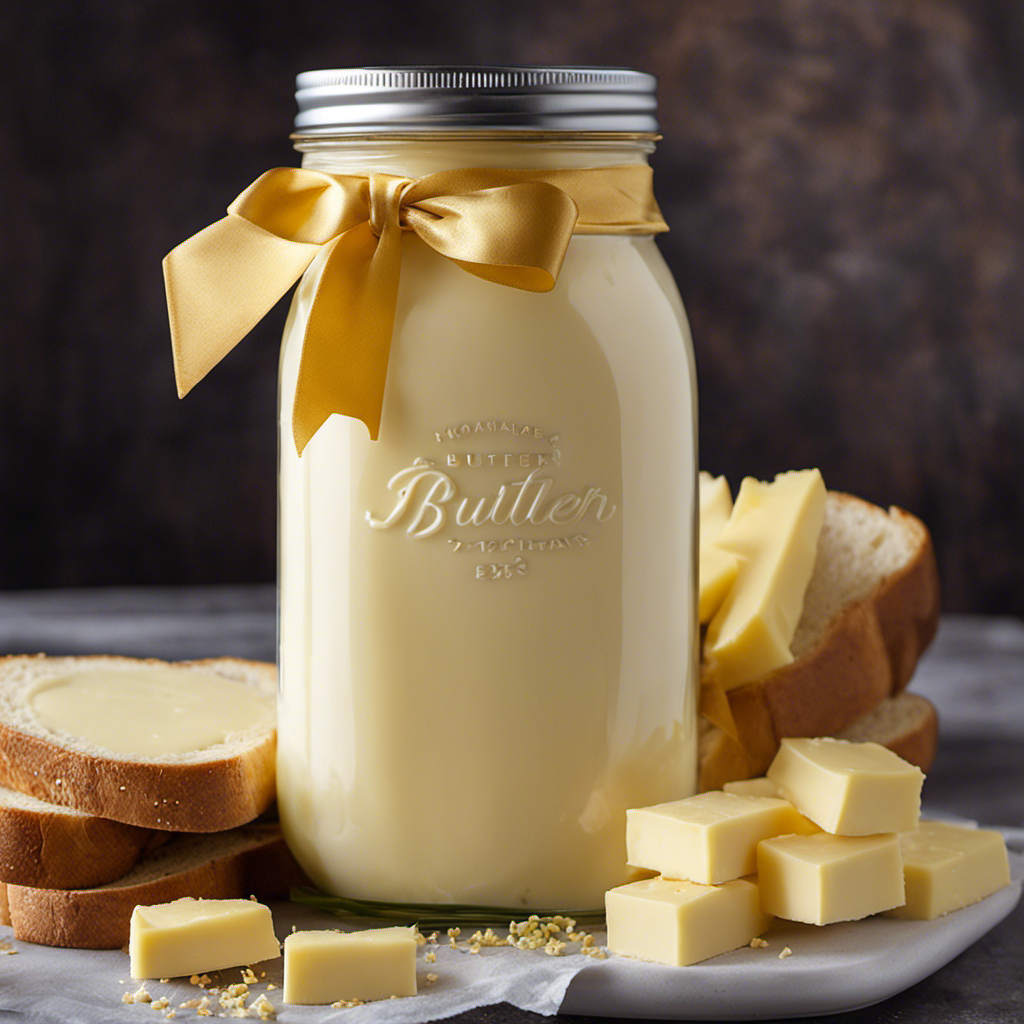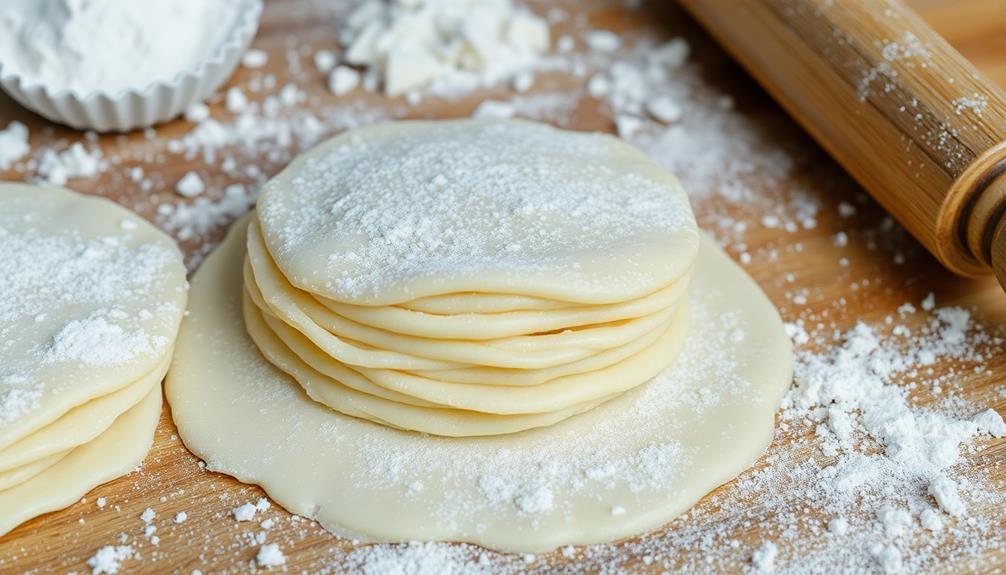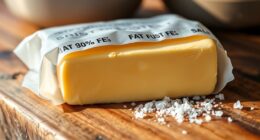I’ve always insisted on precise measurements when cooking. After all, even a slight deviation in the amount of an ingredient can completely change a dish. This is why I’m eager to address a common question: How many tablespoons amount to 1/3 cup of butter?
Don’t worry, I’ve got you covered. In this article, I’ll break down the conversion ratios, provide step-by-step instructions, and even share some handy tips and tricks for measuring butter perfectly every time.
Let’s dive in and demystify this buttery dilemma!
Key Takeaways
- Accurate measurements of butter are crucial in baking to ensure the right balance of ingredients and achieve the desired texture and flavor of baked goods.
- Knowing the conversion ratios for butter measurements, such as 1/3 cup of butter being equivalent to 5 and 1/3 tablespoons, is important for accurate measurement in recipes.
- Converting tablespoons to cups can be helpful when working with recipes that provide measurements in cups, and using a handy conversion table can assist in this process.
- Using a kitchen scale and a conversion chart for butter measurements provides precise and consistent results, eliminating guesswork and ensuring accurate conversions for different recipes.
The Importance of Accurate Measurements
Accurate measurements are crucial when baking because they ensure the right balance of ingredients. When it comes to butter, it is important to measure it correctly to achieve the desired results in your baking.
There are various techniques to measure butter, such as using a kitchen scale or measuring it in tablespoons. However, inaccurate measurements can have a significant impact on your baked goods. Too much butter can make your treats greasy and heavy, while too little can result in a dry and crumbly texture.
The texture and flavor of your baked goods can be greatly affected by the accuracy of your butter measurements. Therefore, it is essential to follow proper measurement techniques to achieve the perfect balance in your recipes.
Understanding Butter Conversion Ratios
When it comes to baking, accurate measurements are crucial for achieving the perfect results. One common measurement that often trips people up is butter. Understanding butter measurement equivalents, such as how many tablespoons are in a cup, can help ensure that your recipes turn out just right.
Butter Measurement Equivalents
To measure 1/3 cup of butter accurately, you can use 5 and 1/3 tablespoons. This is a common conversion ratio that helps ensure precision in your recipes.
When it comes to butter measurement techniques, there are a few tools and tips that can make your life easier in the kitchen. Here are some butter measurement tools to consider:
-
Measuring spoons: These are essential for accurately measuring smaller amounts of butter, such as tablespoons or teaspoons.
-
Butter dish with markings: Some butter dishes have markings that indicate tablespoon measurements, making it convenient to scoop out the desired amount.
-
Kitchen scale: If you prefer weight-based measurements, a kitchen scale can be a valuable tool for measuring butter accurately.
By using these butter measurement tools and techniques, you can ensure that your recipes turn out just right.
Now, let’s explore how to convert tablespoons to cups.
Converting Tablespoons to Cups
You can easily convert tablespoons to cups by using a simple ratio. To help you with this conversion, here is a handy table:
| Tablespoons | Cups |
|---|---|
| 1 | 1/16 |
| 2 | 1/8 |
| 3 | 3/16 |
Now, let’s take a look at converting cups to grams. This is particularly useful when you need to follow a recipe that provides measurements in cups but you prefer to work with grams. Here’s another table to assist you:
| Cups | Grams |
|---|---|
| 1/4 | 30 |
| 1/2 | 113 |
| 1 | 227 |
Converting tablespoons to ounces and cups to grams are essential skills in the kitchen. Accurate measurements ensure that your recipes turn out just right. So, let’s dive into the importance of accurate measurements and how they can make a significant difference in your culinary creations.
Importance of Accurate Measurements
Having precise measurements is crucial in the kitchen because it ensures that your culinary creations turn out just right. Accurate measurements not only help you achieve the desired taste and texture of your dishes, but they also have several other benefits:
-
Consistency: Precise measurements ensure that you can replicate your recipes consistently, allowing you to create the same delicious results every time.
-
Balance of flavors: Accurate measurements help maintain the balance of flavors in your recipes, preventing any ingredient from overpowering the others.
-
Baking success: Baking, in particular, relies heavily on precise measurements. Too much or too little of an ingredient can affect the rise, texture, and overall outcome of your baked goods.
On the other hand, inaccurate measurements can have a significant impact on recipe outcomes:
-
Taste: Incorrect measurements can result in a dish that is either too salty, too sweet, or lacking in flavor altogether.
-
Texture: Inaccurate measurements can lead to a cake that is dense instead of light and fluffy, or a sauce that is too thick or thin.
-
Cooking time: Using incorrect measurements can affect the cooking time, resulting in undercooked or overcooked dishes.
Therefore, it is essential to pay attention to precise measurements in order to achieve the best possible results in your cooking and baking endeavors.
How to Measure Butter in Tablespoons
Simply divide the measurement of butter in cups by three to find out how many tablespoons you’ll need. Measuring butter equivalents can be a handy skill, especially when converting butter to different units.
When a recipe calls for a specific amount of butter in cups, knowing how many tablespoons that translates to can make your cooking experience easier and more accurate. Butter is often sold in sticks, and each stick is equivalent to half a cup or 8 tablespoons.
Converting 1/3 Cup of Butter to Tablespoons
To convert 1/3 cup of butter to tablespoons, all you need to do is divide it by three. It’s a simple calculation that ensures you measure your butter accurately in recipes.
But what about converting other ingredients from cups to tablespoons? Here are some tips to help you convert various measurements accurately:
-
Use a measuring cup: A measuring cup specifically designed for liquid or dry ingredients ensures precise measurements.
-
Follow a conversion chart: Many online resources provide conversion charts for common ingredients like flour, sugar, and milk. These charts help you convert cups to tablespoons and vice versa.
-
Understand ingredient density: Different ingredients have different densities, so converting measurements may vary. For example, a cup of butter may be different in weight compared to a cup of flour.
Tips and Tricks for Measuring Butter
When measuring butter, it’s important to know that different brands may have varying water content. This can affect the accuracy of your measurements.
To measure butter accurately, I recommend using a kitchen scale. This way, you can ensure you’re using the exact amount needed for your recipe.
If you don’t have a scale, you can use the markings on the butter wrapper to measure tablespoons. One stick of butter is equal to 8 tablespoons or 1/2 cup. So if your recipe calls for 1/3 cup of butter, you’ll need a little over 5 tablespoons. It’s always a good idea to check the conversion chart on the butter wrapper to be sure.
Common Mistakes to Avoid When Measuring Butter
One common mistake to avoid is using different brands of butter without considering their varying water content, which can affect the accuracy of your measurements.
When it comes to measuring butter accurately, it’s important to be mindful of these common mistakes:
-
Not softening the butter properly: Softened butter is easier to measure accurately. Make sure to take the butter out of the refrigerator and let it sit at room temperature until it reaches the desired softness.
-
Guessing the measurements: Eyeballing the amount of butter can lead to inaccurate measurements. It’s best to use a measuring spoon or a kitchen scale for precise measurements.
-
Not using the right conversion: Different recipes may use different units of measurement for butter. Make sure to convert the measurements correctly to avoid any confusion.
Handy Conversion Chart for Butter Measurements
Using a handy conversion chart can help you accurately measure butter for your recipes. When it comes to baking or cooking, precise measurements are crucial for achieving the desired results.
A conversion chart specifically designed for butter can be a valuable tool in your kitchen. It provides you with the exact measurements in tablespoons, cups, or grams, depending on your preference. With this chart, you can easily convert any amount of butter required in a recipe.
Whether you need to measure 1/3 cup of butter or any other amount, simply refer to the chart and follow the corresponding measurement. This handy tool takes the guesswork out of measuring butter and ensures your recipes turn out just right every time.
Frequently Asked Questions
Can I Use a Measuring Cup to Measure Butter Instead of Tablespoons?
Sure, you can use a measuring cup to measure butter instead of tablespoons. It’s a convenient way to measure larger amounts. However, for accuracy, it’s recommended to use a kitchen scale, especially in baking. Measuring butter accurately is crucial for the perfect texture and taste. As for the butter vs margarine debate, it’s a personal choice based on taste and dietary preferences.
How Do I Convert Tablespoons to Grams or Ounces?
Converting measurements can be a hassle, but fear not! I’ll show you how to convert tablespoons to grams or ounces. Let’s start with the basics of converting butter measurements.
Is It Okay to Use Margarine Instead of Butter in Recipes?
Using margarine instead of butter in recipes is a personal choice. However, it’s important to note that butter has health benefits like vitamins and healthy fats. It’s best to consult recipes for appropriate substitutions.
How Can I Soften Butter Quickly for Baking?
To quickly soften butter for baking, one method is to grate it using a cheese grater or microwave it in short bursts. Alternatively, you can use alternative ingredients like vegetable oil or applesauce.
Can I Substitute Oil for Butter in a Recipe?
Substituting butter with margarine is a common practice in baking. However, oil can also be a great substitute. Not only does it add moisture and flavor, but it also offers health benefits compared to butter.
Conclusion
In conclusion, accurately measuring ingredients is crucial for successful baking and cooking. When it comes to butter, understanding the conversion ratios and knowing how to measure in tablespoons can make all the difference.
In this article, we learned that 1/3 cup of butter is equal to 5 and 1/3 tablespoons. By following the tips and tricks provided, you can ensure precise measurements and avoid common mistakes. Remember to refer to the handy conversion chart for future reference.
So go ahead, get your butter and measuring spoons ready, and let’s create something delicious!
